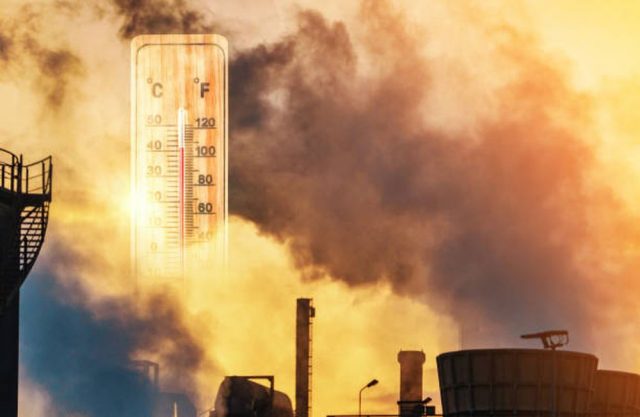Air pollution has impacted the entire world in recent decades. However, a promising breakthrough in sustainable energy not only strives to mitigate pollution effects that harm the environment, it also desires to use the pollution.
On that note, a group of researchers from the University of Pennsylvania, the Illinois Institute of Technology, and the University of Illinois, Chicago, developed a system that can change carbon dioxide pollution into propane.
This exciting breakthrough came in the form of an electrolyzer that helps in the conversion of pollution into propane in an easily expandable and economical way, taking into context all the many benefits it can bring to the entire world.
Interestingly, what makes the electrolyzer unique is that it utilizes readily available, cheap materials to make a more energy-dense product. Attempts to create such a solution in the past have only succeeded in producing low-energy density compounds such as methane.
The new process will create the fundamentals for propane, which has an assortment of uses, from drying clothes and heating water to aviation and powering farm equipment.
Assistant professor of chemical engineering at IIT, Mohammad Asadi, who played a leading role in this research, said:
“Making renewable chemical manufacturing is important. It’s the best way to close the carbon cycle without losing chemicals we currently use daily.”
An assistant professor of chemical engineering at Stanford, Matteo Cagnello, who spearheaded a similar research in 2019, commented on the closing of the carbon cycle at the time, stating:
“One can imagine a carbon-neutral cycle that produces fuel from carbon dioxide and then burns it, creating new carbon dioxide that gets turned back into fuel.”
In case this process is scaled up and expanded for commercial purposes, it might help the United States reach its target of cutting harmful pollution by 50% from 2005 levels by 2030 and reach the global goal of net zero by 2050.
Related:Breakthrough: Scientists Stumble Upon Shocking Innovation for Combating Plastic Pollution
Asadi has partnered with SHV Energy, a global propane distributor with many renewable energy projects underway, to enhance the system.
The head of research and development for sustainable fuels at SHV Energy, Keith Simons, said:
“This is an exciting development which opens up a new e-fuel pathway to on-purpose propane production for the benefit of global users of their essential fuel.”
How Blockchain Technology Helps The Race To Net-Zero
Blockchain technology can play an integral role in supporting the race to attain net-zero emissions by offering transparency, efficiency, and traceability in different aspects of sustainability initiatives, specifically in the energy industry, according to the World Economic Forum (WEF).
One important aspect recognized by the WEF is the development of measurement standards that would operate as the basis for comparison, therefore leading to highly efficient and sustainable options.
In September 2022, the WEF unveiled the Crypto Sustainability Coalition. This coalition is investigating how Web3 and blockchain tools can be used to achieve positive climate action. The new Coalition is a private-public initiative that is hosted by the WEF and features 30 partners.
According to Cathy Mulligan, Kirsteen Harrisson, and Brynly Llyr who work for the WEF platform on tech and innovation:
“It is highly important that the cryptocurrency and general innovation community agree on a shared set of measurement standards.”
The trio insists that measurement is important for enabling technology to contribute to the world’s net-zero goals and is calling on the entire crypto community to agree on a general understanding to set standards that enable various protocols to compare their cumulative environmental impact.
They said:
“Without a solid understanding of the impact a particular technology has, it is unlikely that effective adjustments can be made to improve environmental performance. For any measurement to be helpful across an industry, it must be comparable across different parts of that sector and the methodologies must be clear and transparent.”
Some of how blockchain technology can contribute to support the mission of achieving net-zero emissions include:
Carbon Tracking And Offsetting
Blockchain can support accurate and transparent tracking of carbon emissions and the associated offsetting efforts. By using smart contracts and distributed ledger technology, carbon credits and offsets can be efficiently recorded, traded, and verified. The process guarantees the integrity of emission reduction projects and allows businesses and people to make informed decisions about their carbon footprints.
Related:CleanCarbon Set to Launch CARBO Token
Trading Renewable Energy
The advanced technology can also help in facilitating peer-to-peer energy trading, supporting direct transactions between renewable energy consumers and producers. By using decentralized platforms and smart contracts, the excess renewable energy created can be sold to other users, promoting a decentralized energy grid and supporting the mass adoption of various renewable energy sources.
Supply Chain Transparency
Supply chain transparency can be boosted using blockchain platforms by tracking and validating the origin, authenticity, and environmental impact of these products. The process operates by incorporating blockchain with Internet of Things (IoT) devices, which support the traceability of every step of a product’s journey – ranging from raw material sourcing to transportation, manufacturing, and end-user consumption.
The transparency in supply chain helps identify inefficiencies, reduce waste, and eventually improve the uptake of various sustainable practices.










